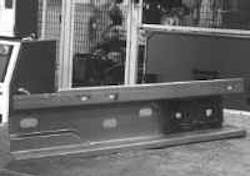Robotic assembly keeps shop on top
Welding cells at Schaller produce a complete bracket assembly every 23.5 sec.
One of the two new cells CMI installed at Schaller Corp.
Schaller Corp., Chesterfield, Mich., is a stamping supplier to the automotive industry, providing brackets, supports, and other structural components. When the 2002-model-year vehicles were introduced, part changes on those cars and trucks made Schaller's robotic welding cells, which were a combination of manual and automated operations, obsolete.
These cells make left and right cabhold-down brackets. Each bracket consists of a rail, subassembly, and three tap plates, all of which are welded together into a U-shaped bracket. The assembled brackets function as the mounting surface between the cab and the vehicle's frame to provide an attachment point for seating mechanisms via the tap plates. Each completed bracket weighs approximately 10 lb, is 3-ft long, and 8-in. wide. The production process for those brackets needed updating, and Schaller turned to Custom Machines Inc. (CMI).
Working together, CMI and Schaller engineers developed new cells, one for the left and one for the right-side brackets. Each included a secondary forming press; an intracell handling robot, two 7-axis servo robots with resistance welding guns; a 6-station 89.20-in.-diameter indexing table; a fourth robot that unloads and packs the assemblies into the dedicated shipping containers; plus a feel-and-positioning mechanism for the tap plates.
The first robot picks up the rail from the stamping press and loads it at the first position of the indexing table. Then it picks up the subassembly from its load conveyor and places it in position on the rail. At this point, the table rotates to the first welding station where the robot welds three tap plates in position and places two welds on the subassembly. A second table rotation takes the whole assembly to a another station where the robot completes eight additional welds. Each bracket gets 16 welds, and the complete hold-down bracket cycle time is approximately 23.5 sec.
System sensors ensure tap-plate pickup and placement, rail and subassembly presence, and that there is a station for checking threads on the subassembly. A final rotation moves the assemblies into position for the fourth robot to unload and place them in shipping containers that hold 102 units. One worker delivers parts to the cell and takes full shipping containers to the shipping department.
Custom Machines Inc.
Adrian, Mich.
www.custommachinesinc.com
[email protected]
